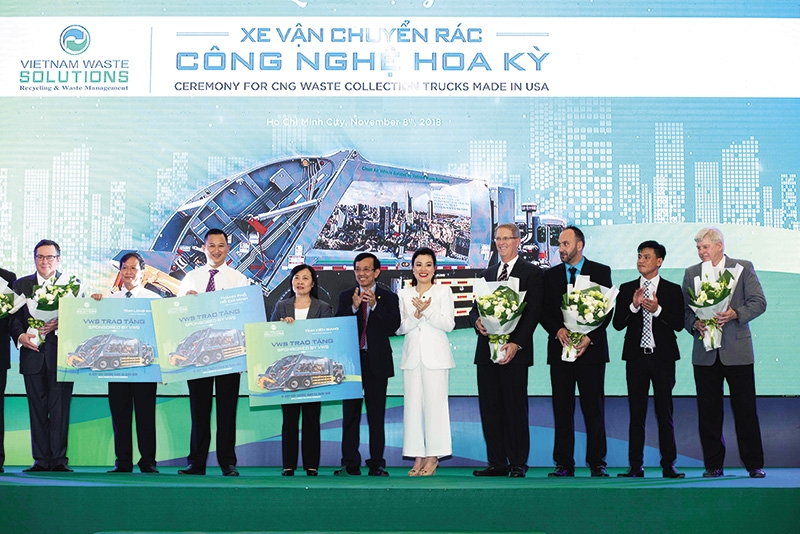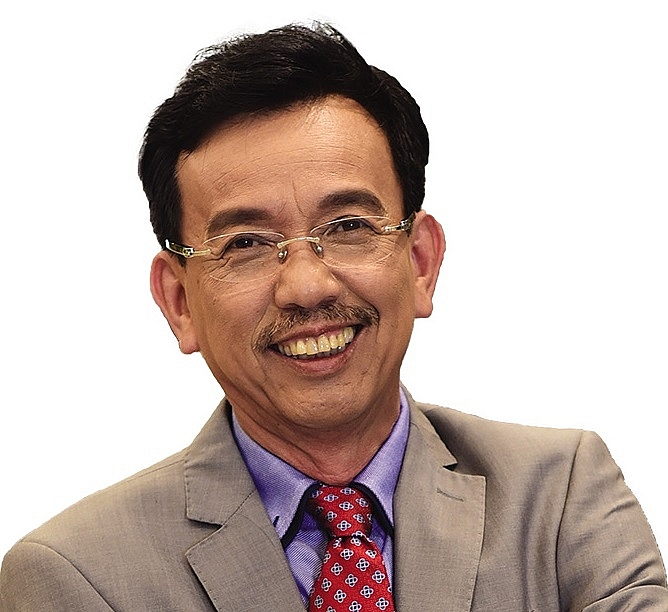Seeking greener waste methods
 |
| CEO of VWS David Duong (pictured, centre) has been proud to pursue the mission of a greener and cleaner Vietnam |
VWS has taken a trip to Europe to explore advanced technology. What have you gained from the trip?
We have just visited five countries to explore the latest waste treatment technologies, most of which have been introduced to local authorities. The old saying goes, you get what you pay for. These state-of-the-art technologies are designed to meet the strict rules of European countries, so the price will be high.
 |
| David Duong |
After visiting a plant in Finland to see the processing lines, we learnt that they also face the same problems as our waste treatment complexes in Vietnam and the US. However, the difference is that their system is divided into three areas, including organic waste treatment, inorganic waste treatment, and landfill areas. European countries took many years to set up this system of waste classification from source to collection, transport and treatment.
At the beginning of this year, several companies visited Vietnam to introduce waste treatment technologies, mainly focusing on waste incineration with competitive prices. Therefore, we decided to go on a field trip and observe and understand the tech in Europe. We learnt that burning trash is the final stage of their waste treatment system, along with waste separation and recycling. This has once again reaffirmed our vision for waste treatment in Vietnam. We have developed a similar pilot system at Da Phuoc Intergrated Waste Management Facility and replicated the model in the Green Environmental Technology Park in Long An.
Due to the rising population and high economic growth, Vietnam is faced with an increasing amount of garbage and more complex waste composition. Also, citizens are not used to waste classification from its source, so it is more challenging for VWS to find suitable technologies. Moreover, the technology to treat medical and hazardous waste is lagging. Therefore, VWS has continuously researched new technologies to process garbage in Vietnam.
Recently, many companies introduced waste incineration technologies in Ho Chi Minh City. What is your advice for the city to apply such technologies?
Municipal authorities are looking to change their waste treatment tech to replace the conventional method of burying waste. The move is in line with the improved economy in the locality. However, the issue lies in selecting technologies that suit the city’s waste composition and local economic conditions.
As Ho Chi Minh City is taking greater efforts to protect the environment, the city should pay more attention to advanced technologies. Worldwide, there are hundreds of companies using waste incineration tech. However, it is crucial to determine technologies suitable for each country rather than focusing on prices and usage duration of equipment.
Although Ho Chi Minh City is home to plenty of low-cost incinerators with a processing capability of 200 tonnes each, it fails to address the growing waste problem with thousands of pieces of garbage discharged every day. The city needs more advanced technologies to deal with the huge amount of daily garbage. Many foreign companies are eager to introduce a wide range of technology to solve this pressing problem. However, they neither identified the waste components nor researched the changing waste composition in Vietnam in the upcoming 20-30 years.
China has failed to select suitable waste technologies, so it is paying the price for environmental pollution and spends huge amounts to tackle the pressing problems. Therefore, we need to consider the issues before investing in new tech to protect the environment and maximise efficiency.
There are both pros and cons in using the two methods of burying and burning waste. The key is to find the most suitable technology for the city. According to VWS research, garbage in the city mainly contains organic waste with high humidity up to 50-60 per cent. It is costly to apply incineration methods to process the city’s mixed garbage, especially with a growing amount of plastic waste.
As one of the first Vietnamese Americans who invested in Vietnam, and after 20 years of operation in Vietnam, you have gained deep insight into waste treatment in the city. Could you share what you have learned in that time?
Thanks to my extensive experience in waste treatment, I have a good understanding of waste composition and volume in Ho Chi Minh City. Over the past two years, we have researched new methods and technologies to recycle waste and reduce costs. It is worth noting that 70 per cent of garbage is organic waste, which can be recycled into usable products. If all of the mixed garbage is burned, it will be costly and polluting.
VWS is making substantial efforts to reduce the method of burning trash. Over the next decade, 15 per cent of waste will be burned while the remaining waste will be processed with waste-to-energy technologies. VWS has hired top-notch experts from Germany, Italy, and the US to research potential tech for the Vietnamese market, which are suitable for the changing waste composition in the country in the future with reasonable costs.
These technologies will maximise recycling and convert the majority of garbage into electricity, compressed natural gas, liquid organic fertilisers, and clean wastewater, among others. They are not only environmentally friendly but also cost-effective. VWS has built a waste-to-energy plant using these technologies with a capacity of 12MW. We are looking for the approval of Vietnam Electricity to connect this plant with the national power grid.
The Green Environmental Technology Park in Long An has been behind schedule, lowering investor’s sentiment. Why is VWS so enthusiastic about pursuing this project?
VWS is investing in the Green Environmental Technology Park to turn it into the major waste treatment complex for the southern key economic zone.
Covering an area of 1,800 hectares, the project will process different types of waste, including household waste, hazardous waste, medical waste, industrial waste, electronic waste, sewage, and old tyres. Most of the waste will be recycled and converted into usable products.
I developed the Green Environmental Technology Park to fulfil a promise to my 75-year-old mother. Long An is her homeland, and she wants me to do something for the province and so I am fully committed. At present, capital and technologies for the project have been well prepared. VWS is accelerating administrative procedures to inaugurate the project in the near future. I am determined to build the park not solely for the profit but for my mission to serve my homeland.
Furthermore, as chairman of the Vietnamese American Business Association, I would like to inspire more Vietnamese American investors to return to Vietnam and contribute to the development of the country.
What the stars mean:
★ Poor ★ ★ Promising ★★★ Good ★★★★ Very good ★★★★★ Exceptional
Related Contents
Latest News
More News
- Businesses ramp up production as year-end orders surge (December 30, 2025 | 10:05)
- Vietjet chairwoman awarded Labour Hero title (December 29, 2025 | 13:06)
- How to unlock ESG value through green innovation (December 29, 2025 | 10:03)
- AI reshapes media and advertising industry (December 29, 2025 | 08:33)
- FPT and GELEX sign deal to develop blockchain tech for global markets (December 29, 2025 | 08:29)
- Vietnam’s GDP forecast to grow by 9 per cent in 2026 (December 29, 2025 | 08:29)
- Women entrepreneurs are key to Vietnam’s economic growth (December 29, 2025 | 08:00)
- Vietnam's top 500 value-creating enterprises announced (December 27, 2025 | 08:00)
- The PAN Group shaping a better future with ESG strategy (December 26, 2025 | 09:00)
- Masan Consumer officially lists on HSX, marking the next phase of value creation (December 25, 2025 | 13:20)

 Tag:
Tag:





















 Mobile Version
Mobile Version